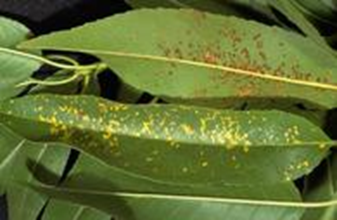Adapted from the article “Alternaria leaf spot and leaf rust of almond” by Joseph Connell, UCCE Farm Advisor, Butte County, and Dr. Jim Adaskaveg, Professor, Department of Plant Pathology and Microbiology, University of California Riverside, in the July, 2013 Sacramento Valley Almond Newsletter.
Almond rust is becoming more prevalent in the Sacramento Valley. The disease is favored by high humidity and leaf wetness. Recent extended wet springs and changes in cultural practices (higher density plantings and micro-sprinkler irrigation with longer, more frequent irrigations) are contributing to higher humidity, more accumulated leaf wetness hours (e.g., dew, rainfall, irrigation, etc.) resulting in higher disease incidence.
Rust is caused by the fungus Tranzschelia discolor and occurs sporadically throughout almond-growing areas in California. It appears as small, yellow, angular spots on the upper surface of leaves and rusty red pustules of spores on the lower surface (Figure 1). The disease is favored by spring and early summer rains and in orchards near rivers, streams or other high spring-summer locations. Excessive levels of nitrogen are also known to increase a tree’s susceptibility.

Figure 1. Almond leaf rust.
The disease causes premature defoliation and will weaken trees, reducing the following year’s bloom. The rust fungus overwinters in infected leaves that remain on the tree, spores contaminating buds and tree bark, and possibly infected twigs. Rust is frequently more severe in young vigorous trees, especially in second to fourth leaf orchards where fungicides have not been applied.
In orchards with a history of rust, treatments should be applied before symptoms appear: An application is prudent five weeks after petal fall and a second application 4 to 5 weeks later to control leaf infections. Monitoring can be done in April through May. Surveys by orchard block. Blocks where 1% leaf infection occurs are at high risk if conducive environments persist. Two or three applications may be needed in orchards that have had severe rust problems. A zinc nutritional spray (zinc sulfate 20-40 lbs./acre) applied in late October to early November resulting in defoliation may reduce overwintering rust inoculum.
Resistance management will be critical to maintain efficacy of currently available fungicides. The following are general suggestions for fungicide resistance management:
- Rotate and mix fungicides that belong to different FRAC group numbers.
- Apply per acre label rates, no every-other-row spraying (upper label rates for QoIs).
- Limit a single mode of action fungicide class (e.g. FRAC Group) application to 1 or 2 per orchard per season.
- Start your fungicide program with a multi-site mode of action material (Captan, Bravo/Echo, Ziram, Rovral, sulfur). Sulfur can be used in combination with single-site mode of action fungicides such as QoI and DMI fungicides.


Leave a Reply